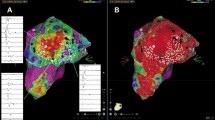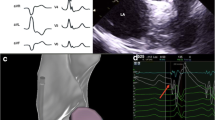Abstract
Purpose
Scars and abnormal electrograms may significantly differ according to the activation wavefront. We propose a new fast technique for reliable comparison between sinus rhythm and ventricular pacing using a single map acquisition and the Rhythmia™ 3D mapping system.
Methods
A special programming of the external stimulator was assuring full stable regular paced-beat bigeminy during spontaneous rhythm. A first map was acquired for the spontaneous cardiac beat. Then the window of detection was moved to the following paced beat, and a second map was available after recalculation by the system, depicting activation and voltage of the paced cardiac beat at the same locations, with an exactly the same number of beats in both maps.
Results
Thirty patients with structural heart disease referred for ablation of ventricular tachycardia underwent this protocol, who were compared with 19 similar patients undergoing repeated maps. Duration of the mapping was significantly shorter compared to controls (34 ± 12 vs 57 ± 14 min, p < 0.0001) without differences in the number of electrograms (6978 ± 7067 vs 9554 ± 4424 for sinus rhythm map and 6610 ± 7240 vs 7783 ± 3804 for paced map, p = ns for both). The technique cannot be completed in five patients (17%), because of arrhythmogenicity, mechanical right bundle branch block, hemodynamical impairment, or bradycardia.
Conclusion
We propose a novel technique for performing maps during sinus rhythm and ventricular pacing using a single acquisition. Beside time saving, this will allow more strict comparisons between different activation wavefronts.






Similar content being viewed by others
References
Di Biase L, Burkhardt JD, Lakkireddy D, Carbucicchio C, Mohanty S, Mohanty P, et al. Ablation of stable VTs versus substrate ablation in ischemic cardiomyopathy: the VISTA randomized multicenter trial. J Am Coll Cardiol. 2015;66:2872–82.
Jaïs P, Maury P, Khairy P, Sacher F, Nault I, Komatsu Y, et al. Elimination of local abnormal ventricular activities: a new end point for substrate modification in patients with scar-related ventricular tachycardia. Circulation. 2012;125:2184–96.
Komatsu Y, Maury P, Sacher F, Khairy P, Daly M, Lim HS, et al. Impact of substrate-based ablation of ventricular tachycardia on cardiac mortality in patients with implantable cardioverter-defibrillators. J Cardiovasc Electrophysiol. 2015;26:1230–8.
Vergara P, Trevisi N, Ricco A, Petracca F, Baratto F, Cireddu M, et al. Late potentials abolition as an additional technique for reduction of arrhythmia recurrence in scar related ventricular tachycardia ablation. J Cardiovasc Electrophysiol. 2012;23:621–7.
Martin CA, Martin R, Maury P, Meyer C, Wong T, Dallet C, et al. Effect of activation wavefront on electrogram characteristics during ventricular tachycardia ablation. Circ Arrhythm Electrophysiol. 2019;12:e007293.
Tung R, Josephson ME, Bradfield JS, Shivkumar K. Directional influences of ventricular activation on myocardial scar characterization: voltage mapping with multiple wavefronts during ventricular tachycardia ablation. Circ Arrhythm Electrophysiol. 2016;9:e004155.
Takigawa M, Relan J, Martin R, Kim S, Kitamura T, Frontera A, et al. Effect of bipolar electrode orientation on local electrogram properties. Heart Rhythm. 2018;15:1853–61.
Cronin EM, Bogun FM, Maury P, Peichl P, Chen M, Namboodiri N, et al. 2019 HRS/EHRA/APHRS/LAHRS expert consensus statement on catheter ablation of ventricular arrhythmias. Heart Rhythm. 2019:S1547–27.
Author information
Authors and Affiliations
Corresponding author
Ethics declarations
Conflict of interest
M Tabuteau and S Capellino are employed by Boston Scientific. R Martin: travel grant from Boston Scientific and Abbott. C Martin received honoraria from Boston Scientific. C Meyer is a consultant for Biotronik, Biosense Webster, Boston Scientific, and Boston Scientific. F Sacher received consulting fees and speaking honorarium from Boston Scientific, Biosense Webster and Abbott. None for other authors.
Additional information
Publisher’s note
Springer Nature remains neutral with regard to jurisdictional claims in published maps and institutional affiliations.
Rights and permissions
About this article
Cite this article
Voglimacci-Stephanopoli, Q., Sacher, F., Martin, C. et al. Creation of sinus rhythm and paced maps using a single acquisition step: the “one acquisition-two maps” technique—a feasibility study. J Interv Card Electrophysiol 61, 235–243 (2021). https://doi.org/10.1007/s10840-020-00793-z
Received:
Accepted:
Published:
Issue Date:
DOI: https://doi.org/10.1007/s10840-020-00793-z




